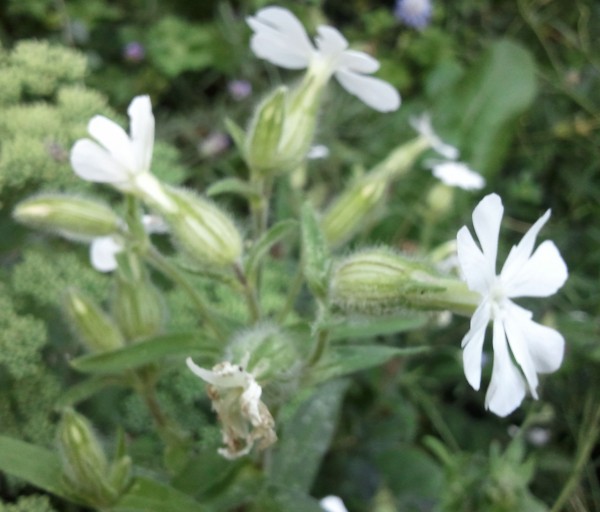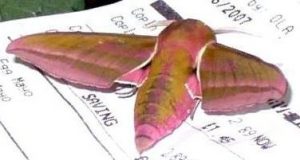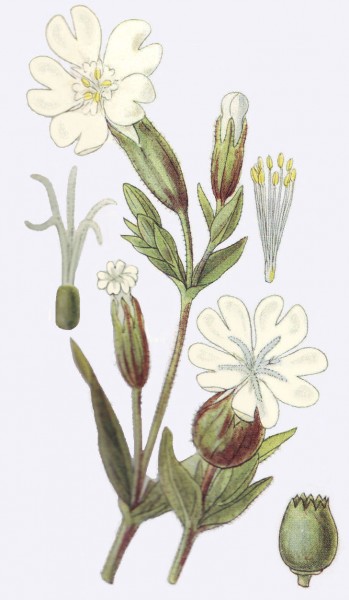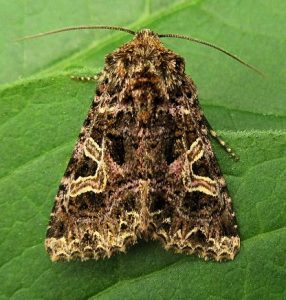CAMPION – WHITE (Silene alba)
Europe, Western Asia, N Africa
Large, creamy WHITE flowers of this plant, a favourite with flower arrangers, seem to glow in the dark.
Silene Alba begins life with a rosette of leaves that are low to the ground. In its second year it puts out tall, downy stems, from one to 4 feet high.
In May WHITE flowers appear, each with five deeply notched petals attached to a seed capsule. The flowers bloom until October.
White campion is a sunlover, growing well on neutral to alkaline soil, in chalk & sand. It is drought tolerant but does not do well on waterlogged soils & resents winter wet.
‘White Campion is a common wildflower that grows in fields, along hedgerows and roadside verges, and on waste ground. It flowers throughout the summer, but it’s actually at night when the blooms produce a heady scent, attracting many feeding moths.’ http://www.wildlifetrusts.org/species/white-campion
https://www.gardenorganic.org.uk/weeds/white-campion
Bees’ Favourite.
White Campion is rich in pollen, attracting bees, hoverflies & other insects, such as the Elephant Hawkmoth, by day; its flowers remain open after dusk with the scent of cloves attracting night-flying moths.
Traditional
“During the reign of Elizabeth I this species was made into a soothing drink, combining it with sugar and wine. In more modern times, the roots are known to be toxic to the larvae of mosquitoes and are used as a deterrent in areas where mosquitoes are problematic. Some people still boil up the roots to make soap.”
http://www.meadowmat.com/home”
White Campion was one of the ingredients in 16th Century Elizabethan pot pourri. The root has been used as a soap substitute for washing clothes, hair, etc. It is thought to have been introduced to the country by neolithic farmers and remains of it have been found on neolithic and bronze age sites. PLANTLIFE
Long Flowering Season
The flowering season for Silene alba in the UK, according to Horwood, was from June to July in 1919. It now blooms from May to September.
Botanical painting by J.N.Fitch, BRITISH WILD FLOWERS in THEIR FAVOURITE HAUNTS, A R Horwood, The Gresham Publishing Company, 1919
The Campion Moth
The Campion Moth, Hadena Rivularis, evolves from a caterpillar which feeds within the seed capsule of silene (red and white campion) & catchfly (lychnis). It mainly flies in May & June, but in the south there is a second brood in August & September.
NatureSpot, https://www.naturespot.org.uk/species/campion
Other names: Bladder Campion, Bull Rattle, Catchfly, Cockle, Cow-rattle, Cuckoo Flower, Evening Close, Evening Lychnis, Flower of the Dead, Flycatcher, Gooseberry Pie, Grandma’s Nightcap, Grave Flower, Mother-die, Plum-puddings, Thunderbolts, Thunder-flower, White Cockle, White Rattle, White Robin.
Invasive?
The ‘bladders’ of each flower store the seeds the plant has made. Seed recovered from archaeological digs and house demolitions is said to have germinated after 70 years burial.
Introduction to Highbury Garden
When I moved into the flat at the top of the house, I put a flower trough on the windowsill outside the kitchen window & got a mixed wildflower fleece to grow in it. Cornflower, Poppy, Corncockle & other seeds sprouted & grew that season – & when the others had finished flowering, White Campion was still bringing in the pollinators. A lovely wildflower. It would have carried on, but someone – a mouse or squirrel – got into the trough & finished it off. Mice can climb brick walls, but the squirrel would have had to get up to the roof & drop down from the gutter… it was an introduction to the local wildlife for me…







